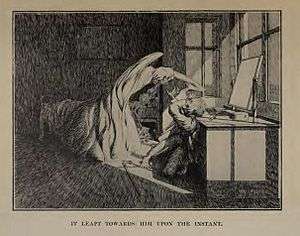'Oh, Whistle, and I'll Come to You, My Lad'
"'Oh, Whistle, and I'll Come to You, My Lad'" is a ghost story by British writer M. R. James, included in his collection Ghost Stories of an Antiquary (1904). It is named after the poem by Robert Burns.
| "'Oh, Whistle, and I'll Come to You, My Lad'" | |
|---|---|
 1904 illustration by James McBryde | |
| Author | M. R. James |
| Country | England |
| Language | English |
| Genre(s) | Horror |
| Publication date | 1904 |
Plot summary
Parkins, the protagonist, a skeptical Cambridge professor, is on holiday in the town of "Burnstow" (a fictionalized version of Felixstowe, Suffolk), on the southeast coast of England. While investigating a Templar ruin for a colleague, he finds a whistle with two Latin inscriptions. On one side it says "Quis est iste, qui venit?". On the other side it says "FLA FUR BIS FLE" in the pattern of a plus sign.
The first inscription is Biblical;[1] Parkins translates it as "Who is it that comes". Visually rearranged as "Fur flabis flebis" the second inscription means roughly "thief, if you blow, you will weep".[2] Not knowing that, Parkins blows the whistle. Back at his hotel the following night, he dreams of a man fleeing towards him in a state of extreme fear and exhaustion before collapsing right in front of him. In the distance, the pursuer appears, moving in a strange fashion and with incredible speed. The next day he encounters a boy who was terrified by a white figure that had appeared at the window of Parkins' hotel room. Upon returning to his room, he notices that the room's second, unused bed is in disorder. Later, while alone in his hotel room, he sees someone get up from the adjacent and empty bed. The figure, made up of the bedclothes, attacks Parkins, but he is saved by one of the other guests.[3]
Adaptations
The BBC has filmed the story twice as Whistle and I'll Come to You, firstly in 1968 in a version directed by Jonathan Miller and starring Michael Hordern, and again in 2010 starring John Hurt and Sophie Thompson.
Abby Howard adapted the story as a web comic.
The Bengali writer Hemendra Kumar Roy adapted this story as "Bajale Banshi Kache Asi".
References
- Isaiah 63:1
- Pardoe, Rosemary (August 24, 2007). "(11) What's the meaning of the "FUR/FLA/FLE/BIS" inscription in "Oh, Whistle, and I'll Come to You, My Lad"?". M.R. James Frequently Asked Questions. Retrieved 15 January 2011.
- James, M.R. (1993). Collected ghost stories (Repr. ed.). Ware, Hertfordshire: Wordsworth. pp. 65–81. ISBN 1853260533.
External links

- A Podcast to the Curious: Episode 7a - 'Oh, Whistle, and I'll Come to You, My Lad'.